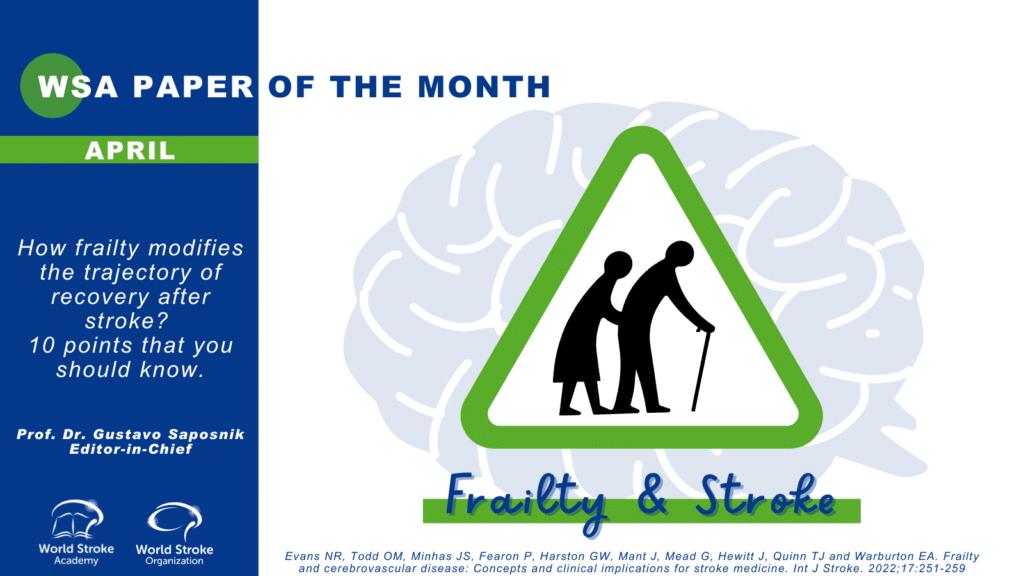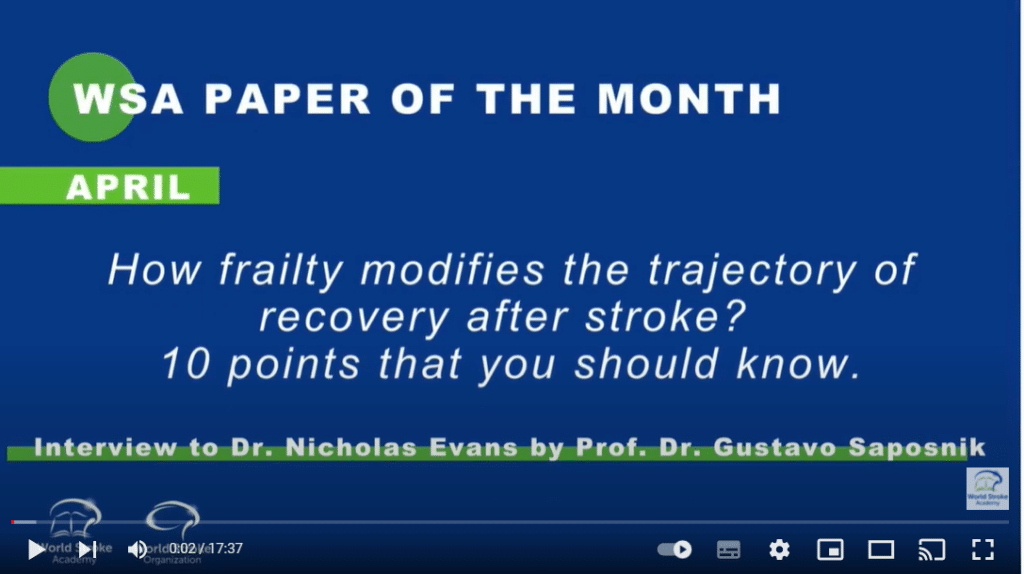The Paper of the Month April
30 Mar 2022Title: How frailty modifies the trajectory of recovery after stroke? 10 points that you should know.
Title: How frailty modifies the trajectory of recovery after stroke? 10 points that you should know.
Author: Prof. Dr. Gustavo Saposnik, Editor-in-Chief WSA
This article is a commentary on the following
“The true measure of any society can be found in how it treats its most vulnerable members.”Mahatma Gandhi (Humanitarian lawyer and civil rights leader, 1869-1948) |
Commentary:
Frailty emerged as a concept to characterize the complex interrelationship of age, multiple comorbidities, and physical or cognitive impairment, which affect patients’ independency and daily activities. The operationalization of frailty was developed over two decades ago derived from the Cardiovascular Health Study. Freid et al. defined frailty as a clinical syndrome in which three or more of the following criteria were present: i) unintentional weight loss (10 lbs in past year), ii) self-reported exhaustion, iii) weakness (grip strength), iv) slow walking speed, and v) low physical activity.1
In the present article published in IJS,2 the authors reviewed the implications of frailty for stroke medicine. Perhaps, one of the most valuable lessons is how the authors summarized evidence-based concepts to enhance the traditional “eyeballing” approach in medicine to identify sick patients (sometimes expressed as a “gut feeling”) that may not be amenable to a diagnostic or therapeutic procedure.3
A recent systematic review and meta-analysis including 18 studies (n= 48,009 participants) also provided relevant information regarding the prevalence of frailty in stroke patients. Those patients were over twofold more likely to be frail than individuals without stroke (pooled OR = 2.32, 95% CI = 2.11–2.55; I2 = 0.0%).4
Overall, the prevalence frailty in a community-dwelling population age 65 years and older range between 7-10%.1, 5 Other studies showed that nearly 50% of stroke patients fulfill the frailty criteria.4
What have we learned about the influence of frailty in the management of patients with cerebrovascular disease?. Would frailty affect our decision-making process for acute reperfusion therapies, stroke prevention or rehabilitation?
Herein, I summarize 10 practical concepts that non-expert clinicians and stroke neurologists may want to know:
1) Conceptualization of Frailty: As highlighted by the authors, the concept of frailty includes the interrelationship of several characteristics. As such, ageing, comorbidities, and functional or cognitive impairments commonly co-exist, but are not exclusive. In other words, younger individuals with absence of comorbid conditions or a physical impairment may be frail. Contrarily, a 90-year-old with hypertension, dyslipidemia, and heart failure who requires assistance for banking may not qualify for frailty.
2) Frailty is the result of accumulative deficits in different areas: The development of a clinical event (i.e.: ischemic or hemorrhagic stroke) usually adds cumulative deficits manifested by a reduction in muscle strength, poorer nutrition, lower mobility and activity levels that is reflected by higher frailty scores. In frail stroke patients, this new condition typically does not fully return to the previous baseline status.6
3) Simple measures: Non-expert geriatricians can identify the cumulative deficit to assess frailty by assessing the 5 measurable components (e.g. patients’ weight, level of exhaustion or fatigue, iii) grip strength, iv) walking speed test, and v) level of physical activity (e.g. time in bed or at home)7, 8 as described by Freid et al.1
4) Frailty scales: There are different measures of frailty that can be used depending on the clinical setting. For example, the cumulative frailty index and the Clinical Frailty Scale (CFS) were used at bedside or in outpatient clinics, whereas the Hospital Frailty Risk Score was used in health services research.1, 6,
5) The use of frailty scores for patient selection/exclusion in clinical trials: Most randomized clinical trials use the modified Ranking scale (mRS) for excluding patients with pre-existing disability as a proxy measure of frailty. However, as highlighted by the authors,2 the mRS correlates but not necessarily reflect, the frailty of a potential participant. In other words, a measure of frailty may provide a more comprehensive assessment to determine patients’ eligibility as a better proxy measure of response to critical stroke therapies (e.g. reperfusion therapies).10-12
6) Frailty and reperfusion therapies: Although some studies showed a benefit with endovascular thrombectomy (EVT) among patients initially excluded (e.g. low ASPECT score- <5) from the 5T trials (Hermes collaboration),13 pre-stroke frailty is prevalent in real-world patients eligible for EVT and is an important predictor of poor outcomes.14, 15 For example, the prevalence of frailty among participants undergoing EVT was 28% and 29.7%, respectively.14, 15 After adjustment for covariates, frailty was an independent predictor of outcome. A more important consideration relates to the contemporary intention of expanding the criteria for EVT in more complex groups (e.g. low ASPECT scores). In RESCUE-Japan, an open label trial, patients with a large vessel occlusion and large ischemic areas (determined by an ASPECTS values between 3 to 5) were randomly assigned to EVT or best medical therapy. Although the authors showed higher rates of mRS 0 to 3 at 90 days in the EVT group (31.0% vs. 12.7%; p=0.002), there was no difference between groups for the traditional mRS 0 to 2 (14% vs 6.9%; p=NS). In other words, the great majority of patients had a mRS≥3 (with ~20% mortality) at 90 days. Unfortunately, there were no metrics of frailty reported in this trial, but one can speculate a 25-30% of eligible patients fulfilling a frailty criterion. These findings illustrate that i) the addition of a frailty score may have served to exclude patients that would unlikely benefit from EVT given the larger ischemic region, and ii) an potential effect modification by frailty in RESCUE-JAPAN (meaning that frail patients enrolled in this trial may not achieve a benefit with EVT given our current evidence) downplaying the results.
7) The vicious circle of frailty: As stroke patients commonly have an increased number of vascular risk factors, which is usually associated with more severe strokes and a decreased response to treatment (or functional recovery after treatment) leading to higher incident risk of post-stroke complications, longer length of hospital stay, lower likelihood to be discharge to the same place of residence prior to the stroke index and overall poorer recovery index.4, 10, 12
8) Impact of Frailty on Stroke Outcomes: Several studies showed an association between higher stroke severity, stroke disability and mortality with lower grip strength, slow gait walk and higher frailty scores.7, 14, 16-19
9) Frailty and disposition after stroke: As illustrated by the authors, a study conducted in the USA showed that nearly 50% of frail patients are discharged to nursing homes, and contrarily non-frail patients are more likely to be discharge to a rehabilitation institution.7, 20
10)Radiological features associated with frailty: Although white matter changes and “silent” ischemic stroke may affect a vast population with poorly controlled vascular risk factors, leukoaraiosis, atrophy, and remote infarcts were associated with poorer functional and cognitive outcomes at 90 days among frail patients after stroke.21, 22
In summary, frailty is a common phenomenon among stroke patients. Given the practical implications on stroke severity, length of hospitalization, outcomes and quality of life, frailty scores should be incorporated in our clinical assessment and for patient selection in randomized stroke trials.
References:
- Fried LP, Tangen CM, Walston J, Newman AB, Hirsch C, Gottdiener J, Seeman T, Tracy R, Kop WJ, Burke G and McBurnie MA. Frailty in older adults: evidence for a phenotype. J Gerontol A Biol Sci Med Sci. 2001;56:M146-56.
- Evans NR, Todd OM, Minhas JS, Fearon P, Harston GW, Mant J, Mead G, Hewitt J, Quinn TJ and Warburton EA. Frailty and cerebrovascular disease: Concepts and clinical implications for stroke medicine. Int J Stroke. 2022;17:251-259.
- Sibbald M, Sherbino J, Preyra I, Coffin-Simpson T, Norman G and Monteiro S. Eyeballing: the use of visual appearance to diagnose ‘sick’. Med Educ. 2017;51:1138-1145.
- Palmer K, Vetrano DL, Padua L, Romano V, Rivoiro C, Scelfo B, Marengoni A, Bernabei R and Onder G. Frailty Syndromes in Persons With Cerebrovascular Disease: A Systematic Review and Meta-Analysis. Front Neurol. 2019;10:1255.
- Collard RM, Boter H, Schoevers RA and Oude Voshaar RC. Prevalence of Frailty in Community-Dwelling Older Persons: A Systematic Review. Journal of the American Geriatrics Society. 2012;60:1487-1492.
- Rockwood K, Mitnitski A, Song X, Steen B and Skoog I. Long-term risks of death and institutionalization of elderly people in relation to deficit accumulation at age 70. J Am Geriatr Soc. 2006;54:975-9.
- Holodinsky JK, Yu AYX, Kapral MK and Austin PC. Using random forests to model 90-day hometime in people with stroke. BMC Medical Research Methodology. 2021;21:102.
- McDermid I, Barber M, Dennis M, Langhorne P, Macleod MJ, McAlpine CH and Quinn TJ. Home-Time Is a Feasible and Valid Stroke Outcome Measure in National Datasets. Stroke. 2019;50:1282-1285.
- Gilbert T, Neuburger J, Kraindler J, Keeble E, Smith P, Ariti C, Arora S, Street A, Parker S and Roberts HC. Development and validation of a Hospital Frailty Risk Score focusing on older people in acute care settings using electronic hospital records: an observational study. The Lancet. 2018;391:1775-1782.
- Kanai M, Noguchi M, Kubo H, Nozoe M, Kitano T, Izawa KP, Mase K and Shimada S. Pre-Stroke Frailty and Stroke Severity in Elderly Patients with Acute Stroke. J Stroke Cerebrovasc Dis. 2020;29:105346.
- Munthe-Kaas R, Aam S, Saltvedt I, Wyller TB, Pendlebury ST, Lydersen S, Hagberg G, Schellhorn T, Rostoft S and Ihle-Hansen H. Is Frailty Index a better predictor than pre-stroke modified Rankin Scale for neurocognitive outcomes 3-months post-stroke? BMC Geriatr. 2022;22:139.
- Noguchi M, Kubo H, Kanai M, Nozoe M and Shimada S. Relationship between pre-stroke frailty status and short-term functional outcome in older patients with acute stroke-A mediation analysis. Arch Gerontol Geriatr. 2021;94:104370.
- Goyal M, Menon BK, van Zwam WH, Dippel DW, Mitchell PJ, Demchuk AM, Davalos A, Majoie CB, van der Lugt A, de Miquel MA, Donnan GA, Roos YB, Bonafe A, Jahan R, Diener HC, van den Berg LA, Levy EI, Berkhemer OA, Pereira VM, Rempel J, Millan M, Davis SM, Roy D, Thornton J, Roman LS, Ribo M, Beumer D, Stouch B, Brown S, Campbell BC, van Oostenbrugge RJ, Saver JL, Hill MD, Jovin TG and collaborators H. Endovascular thrombectomy after large-vessel ischaemic stroke: a meta-analysis of individual patient data from five randomised trials. Lancet. 2016;387:1723-31.
- Joyce N, Atkinson T, Mc Guire K, Wiggam MI, Gordon PL, Kerr EL, Patterson CE, Mc IJ, Roberts GE, Flynn PA, Burns P, Rennie IR, Taylor Rowan M, Quinn TJ and Fearon P. Frailty and stroke thrombectomy outcomes-an observational cohort study. Age Ageing. 2022;51.
- Pinho J, Kuppers C, Nikoubashman O, Wiesmann M, Schulz JB, Reich A and Werner CJ. Frailty is an outcome predictor in patients with acute ischemic stroke receiving endovascular treatment. Age Ageing. 2021;50:1785-1791.
- Boyd S, Tse W, Lavingia K and Amendola M. Frailty Measurement and Implications for Cerebrovascular Disease Management in a Veteran Based Population. Ann Vasc Surg. 2021;76:134-141.
- Evans NR, Wall J, To B, Wallis SJ, Romero-Ortuno R and Warburton EA. Clinical frailty independently predicts early mortality after ischaemic stroke. Age Ageing. 2020;49:588-591.
- Gugganig R, Aeschbacher S, Leong DP, Meyre P, Blum S, Coslovsky M, Beer JH, Moschovitis G, Muller D, Anker D, Rodondi N, Stempfel S, Mueller C, Meyer-Zurn C, Kuhne M, Conen D, Osswald S and Swiss AFI. Frailty to predict unplanned hospitalization, stroke, bleeding, and death in atrial fibrillation. Eur Heart J Qual Care Clin Outcomes. 2021;7:42-51.
- Kilkenny MF, Phan HT, Lindley RI, Kim J, Lopez D, Dalli LL, Grimley R, Sundararajan V, Thrift AG, Andrew NE, Donnan GA, Cadilhac DA, Stroke I and the Au SCRC. Utility of the Hospital Frailty Risk Score Derived From Administrative Data and the Association With Stroke Outcomes. Stroke. 2021;52:2874-2881.
- Seamon BA and Simpson KN. The Effect of Frailty on Discharge Location for Medicare Beneficiaries After Acute Stroke. Arch Phys Med Rehabil. 2019;100:1317-1323.
- Appleton JP, Woodhouse LJ, Adami A, Becker JL, Berge E, Cala LA, Casado AM, Caso V, Christensen HK, Dineen RA, Gommans J, Koumellis P, Szatmari S, Sprigg N, Bath PM, Wardlaw JM and Investigators E. Imaging markers of small vessel disease and brain frailty, and outcomes in acute stroke. Neurology. 2020;94:e439-e452.
- Bu N, Khlif MS, Lemmens R, Wouters A, Fiebach JB, Chamorro A, Ringelstein EB, Norrving B, Laage R, Grond M, Wilms G, Brodtmann A and Thijs V. Imaging Markers of Brain Frailty and Outcome in Patients With Acute Ischemic Stroke. Stroke. 2021;52:1004-1011.
Author interview:
Dr. Nicholas R Evans, University of Cambridge, Department of Clinical Neurosciences, Neurology Unit
1. What did you set out to study?
Frailty is the loss of physiological reserve to withstand a stressor response, and is distinct from age, co-morbidities, and disability. It is increasingly recognised as an independent risk factor for poor recovery and increased mortality across a range of medical conditions, but its role in stroke is still poorly understood. Our review aimed to provide a comprehensive evaluation of the role of frailty at different points along the stroke pathway.
2. Why this topic?
As clinicians we often recognise frailty when we see it, but this is often done subconsciously. Recognising the importance of frailty, and how we can best evaluate it in the acute stroke setting, may mean that we can improve prognostication and may have implications for our clinical decision-making.
3. What were the key findings?
We found that frailty has important disease-modifying and treatment-modifying effects at every stage of the stroke pathway, from appearing to attenuate the benefit from hyperacute reperfusion therapies to affecting recovery after stroke (physical, cognitive, and psychological). Frailty is also independently associated with an increased risk of stroke, and this bi-directional relationship between frailty and stroke may lead to a self-propagating cycle. There are also lots of unknowns that represent important areas for future research.
4. Why is it important? Or how might these results impact clinical practice?
Frailty is common, with up to three quarters of people admitted with a stroke demonstrating a degree of frailty or pre-frailty, so the implications for our clinical practice are enormous. However, despite its prevalence, we are only now beginning to recognise its importance. It’s important to remember that a lot of our evidence-base in stroke is based on studies conducted in more robust individuals without frailty. The outcomes in these research populations may be different to those seen in the more frail populations we see in routine clinical practice. Consequently, we need pragmatic research studies evaluating the effect of frailty on interventions in the frailer cohorts we see in clinical practice.
5. What surprised you most?
I think how common frailty is amongst individuals presenting with stroke, and what a profound effect it can have on outcomes along the whole of the clinical course after a stroke. I was used to the “gut instinct” when I saw someone with frailty and how it may affect their response to treatment or recovery, but was surprised by the extent of the effect. Frailty is certainly something I consider more actively now when making treatment decisions, but there are still lots of unknowns where we need more research.
6. What’s next for this research?
Shifting demographics means that we are likely to see a rise in the prevalence of frailty globally. As we’ve said, we need research that looks specifically at how frailty may influence the clinical course of stroke and how it may have a treatment-modifying effect on treatments across the stroke pathway. Such results will have important implications either way: if there is a treatment-modifying effect from frailty then this may influence clinical decision-making, whereas if individuals with frailty continue to benefit then this may ensure we avoid nihilistic attitudes in the management for such individuals.
That said, not only do we need research into how frailty affects treatment and outcomes, but we also need a better understanding of the mechanisms by which frailty may influence these, and what interventions may be effective in reducing the effect of frailty. There have been some promising interventions for frailty in the setting of cardiac rehabilitation – we need to try a similar approach in stroke rehabilitation.
7. Is there anything you’d like to add?
The effect of frailty in stroke has been identified as a research priority by the James Lind Alliance Priority Setting Partnership in the United Kingdom, supported by the Stroke Association (https://www.stroke.org.uk/research/priority-setting-partnership). With the support of the British and Irish Association of Stroke Physicians and National Institute for Health Research, we have formed a collaboration to facilitate research into frailty in stroke, and it is great to see that developing into international collaborations through a newly-formed International Stroke Recovery and Rehabilitation Alliance working group. It is exciting to have involvement from healthcare professionals and researchers across all disciplines from around the world, which will hopefully provide excellent foundations for future work to inform our clinical care to individuals affected by both frailty and stroke.



